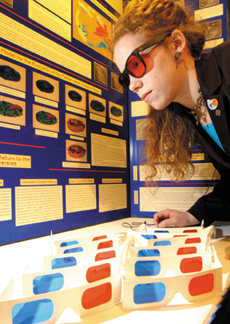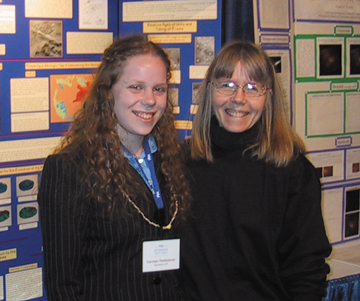 The year was 1994
— NASA’s Magellan spacecraft burned up entering Venus’ atmosphere
after recording four years of data about the planet’s surface. Barb Tewksbury
was teaching juniors and seniors at Hamilton College in New York an elective
course in planetary geology. Her daughter — Carolyn, age 10 — wanted
in on the action.
The year was 1994
— NASA’s Magellan spacecraft burned up entering Venus’ atmosphere
after recording four years of data about the planet’s surface. Barb Tewksbury
was teaching juniors and seniors at Hamilton College in New York an elective
course in planetary geology. Her daughter — Carolyn, age 10 — wanted
in on the action. A simple geologic mapping project of the craters on Venus gave Carolyn her first taste for research. “She mapped impact craters and their deposits and learned how to recognize craters that have been modified by volcanism or tectonism,” Barb says.
Carolyn was hooked. “I knew I wanted to be an astronaut,” she says. Venus is her current focus with Mars her ultimate goal. “I hope we’re there. I hope we’re ready to go when I come up through the ranks.”
Carolyn Tewksbury uses 3-D glasses to view her Intel Science Talent Search poster. Photo courtesy of Intel Corp. Affairs.
Now 18 years old, Carolyn is off to Smith College in the fall with a $20,000 scholarship for coming in as one of the top 10 in the 2003 Intel Science Talent Search on March 11. Hers was the only geoscience project among the 40 finalists. She is also presenting her project on Venus, like any good discovery, to the scientific community. A week after the Intel contest in Washington, she was off to present her poster at the Lunar and Planetary Science Conference in League City, Texas. She has also given her poster presentations at meetings of the Geological Society of America.
Carolyn looked to her mother as mentor in geology, but needed outside expertise when it came to Venus. Barb’s principal field is structural geology here on Earth. After six years of research, Carolyn’s knowledge of Venus had surpassed her mother’s ability to help Carolyn focus her work on cutting-edge questions about the planet, Barb says. She recommended Carolyn turn to Vicki Hansen of the University of Minnesota in Duluth.
Carolyn “picked out this great region, where looking at it I thought we might have a collapsed crustal plateau,” Hansen says. “Crustal plateaus are large, steep-sided, flat-topped features on Venus that are characterized by highly deformed crust called tessera,” Carolyn explains. “Carolyn’s work represents the first comprehensive geological mapping of arcuate bands of tessera that have been interpreted, correctly I think, as a coherent collapsed crustal plateau,” Hansen says.
Carolyn’s principal, Richard Hunt, is extremely proud of her. She is the first student from Clinton Senior High School to apply to the Intel Science Talent Search, let alone become a finalist and scholarship-winner at the national competition. “It’s the most rewarding thing that has ever happened to our school,” he says. Carolyn’s talents are not all tied up in science either. “I first got to know Carolyn when she was in eighth grade,” Hunt says. “She performed a Scottish Highland dance in front of 650 high school kids for a festival celebrating the heritage of our town. That takes confidence.”
Carolyn is also a competitive bagpipe player. This year’s first indoor Highland dancing competition was held April 5. Bagpipe competitions, however, don’t start until the summer. As she explains, “most people don’t appreciate bagpipes indoors.”
Christina Reed

 Barb Tewksbury
is the Stephen Harper Kirner Professor of Geology at Hamilton College, and is
currently investigating deformation in Proterozoic metamorphic rocks of the
Grenville Province in northern New York State. “I am keenly interested
in effective and innovative teaching strategies and course design,” she
says. With funding from the National Science Foundation, Tewksbury is working
with colleagues from other institutions on a five-year program called “On
the Cutting Edge.”
Barb Tewksbury
is the Stephen Harper Kirner Professor of Geology at Hamilton College, and is
currently investigating deformation in Proterozoic metamorphic rocks of the
Grenville Province in northern New York State. “I am keenly interested
in effective and innovative teaching strategies and course design,” she
says. With funding from the National Science Foundation, Tewksbury is working
with colleagues from other institutions on a five-year program called “On
the Cutting Edge.” 